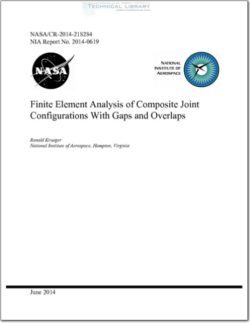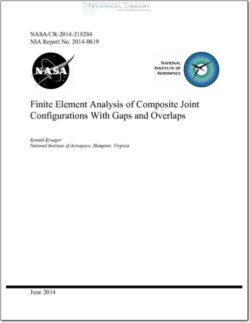NASA-CR-2014-218284-NIA-RP-2014-0619

- Version
- 332 Downloads
- 10.57 MB File Size
- 1 File Count
- April 19, 2016 Create Date
- April 19, 2016 Last Updated
Finite Element Analysis of Composite Joint Configurations with Gaps and Overlaps

ABSTRACT
The goal of the current study is to identify scenarios for which thermal and moisture effects become
significant in the loading of a composite structure. In the current work, a simple configuration was
defined, and material properties were selected. A Fortran routine was created to automate the mesh
generation process. The routine was used to create the models for the initial mesh refinement study.
A combination of element length and width suitable for further studies was identified. Also, the
effect of the overlap length and gap length on computed shear and through-thickness stresses along
the bondline of the joints was studied for the mechanical load case. Further, the influence of
neighboring gaps and overlaps on these joint stresses was studied and was found to be negligible.
The results suggest that for an initial study it is sufficient to focus on one configuration with fixed
overlap and gap lengths to study the effects of mechanical, thermal and moisture loading and
combinations thereof on computed joint stresses.
BACKGROUND
Environmental factors that affect the performance of composite laminates include temperature,
moisture content and hygrothermal history. Early studies showed that residual stress relaxation due
to hygrothermal history altered the static mechanical strain necessary to cause matrix cracking in
experiments [1]. Depending on material type and hygrothermal history, this effect was shown to
either increase or decrease the resistance to matrix cracking. Matrix crack growth in laminates
subjected to creep load and severe environments may require the development of viscoelastic failure
criteria [1]. The viscoelastic response of laminated composites under the influence of mechanical
and hygrothermal loads was studied analytically [2]. Application of the analysis included the effect
of residual thermal stress relaxation upon creep in laminated composite plates under mechanically
applied loads [3]. Generalized plane-strain finite elements were also formulated using linear
viscoelastic theory. Analyses of changes in interlaminar stresses at the free edge of multidirectional
laminates subjected to cyclic load conditions indicated that several variables can affect peak
amplitude in interlaminar stresses and cycle-to-cycle variations in stress state. These influencing
parameters were determined to be frequency, stress ratio, relative dwell time and environment [4].
PROBLEM OVERVIEW
An overview of a scenario where combined mechanical and thermal load effects become significant
was discussed in detail in reference 1 and is presented in Figure 1. For the pure elastic case, the
transverse residual stress in the ply is tensile and the stresses increase as the temperature drops from
the stress free temperature T (My to an ambient value (see dashed red line along path (D —> (D).
During moisture absorption, the transverse residual stress drops and may become compression (see
dashed red line along path (23). An increase in temperature will increase the compressive stress (see
dashed black line along path (3). The stress increases during moisture desorption (see dashed black
line along path @) and the cycle starts from the beginning (see dashed red line along path (D). A
stress relaxation, however, may occur caused by accelerated viscoelastic effects due to an increase
in temperature and moisture content (see solid red line along path ®'). As the temperature drops, the
tensile transverse residual stress continues to increase beyond the original residual tensile stress (see
solid red line path along (5)) [1]. For the viscoelastic case, therefore, the presence of the thermal load
could make the stresses worse due to the effect of the previous creep.
These combined thermal and moisture effects may become significant in the loading of a composite
fuselage structure where several individual components are connected with longitudinal joints, as
shown in Figure 2. Since airframe manufactures have recently become interested in joint
configurations, which may be designed with multiple overlaps and resin gaps as shown in Figure 3,
it has become important to understand the stresses at the bondline. Overlap length, (5, and resin gap
size, c, shown in Figure 3a may also vary. As the overlap length, (5, approaches zero (6 —> 0) the
design resembles the traditional splice joint, as shown in Figure 3b.
The current study, therefore aims at identifying scenarios where thermal and moisture effects
become significant in the loading of a composite structure. Linear and geometrically non-linear
finite element analyses of simple and more complex examples are required first, to study the single
and combined effects of mechanical, thermal and hygral loading on the computed strains and
stresses. The results from this initial study of simple specimens and load scenarios will be used as
guidance to define the next steps. These next steps may include additional analysis of more complex
specimens under different load combinations and more advanced Viscoelastic analysis, as well as
testing.
The focus of the present work was to study the effect of overlap length and gap length on shear and
through-thickness stresses along the bondline of staggered overlap joints using linear and
geometrically non-linear finite element analyses. First, the material properties obtained from the
literature are discussed. Second, the selected specimen configuration is introduced. Third, the finite
element analysis is described, including a Fortran routine that was created to quickly generate two-
and three-dimensional models of different configurations of interest. Fourth, the results of an initial
mesh refinement study are discussed for the mechanical load case. Fifth, the effects of the overlap
length and gap length on computed shear and through-thickness stresses at the bondline are
examined. A summary and outlook for future steps are provided. The description of the Fortran
routine and the required user input, as well as an Abaqus/Standard® input deck, are given in the
appendix.
| File | Action |
|---|---|
| NASA-CR-2014-218284-NIA-RP-2014-0619 Finite Element Analysis of Composite Joint Configurations with Gaps and Overlaps.pdf | Download |

Comment On This Post